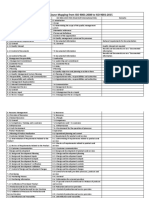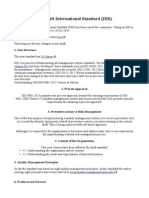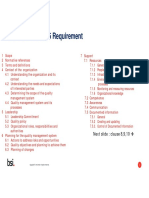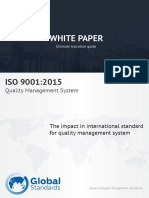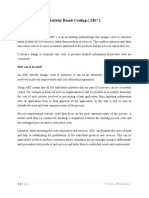Comparison Between ISO 9001 - 2008 and ISO 9001 - 2015
Comparison Between ISO 9001 - 2008 and ISO 9001 - 2015
Uploaded by
imamudeenCopyright:
Available Formats
Comparison Between ISO 9001 - 2008 and ISO 9001 - 2015
Comparison Between ISO 9001 - 2008 and ISO 9001 - 2015
Uploaded by
imamudeenOriginal Description:
Original Title
Copyright
Available Formats
Share this document
Did you find this document useful?
Is this content inappropriate?
Copyright:
Available Formats
Comparison Between ISO 9001 - 2008 and ISO 9001 - 2015
Comparison Between ISO 9001 - 2008 and ISO 9001 - 2015
Uploaded by
imamudeenCopyright:
Available Formats
Comparison between ISO 9001:2008 and ISO 9001:2015
ISO 9001:2015 was released 23 September 2015.
Following are the key changes in this standard from ISO 9001:2008:
1. New Structure:
The new standard has 10 clauses
ISO is in process of harmonizing all management system standards. For this a harmonized
structure (Annex SL) has been developed.
2. Process Approach:
ISO 9001:2015 promotes the process approach beyond the existing requirements of ISO
9001:2008. Clause 4.4 (Quality management system and its processes) provides specific
requirements for adopting a process approach.
3. Preventive Action vs Risk Management:
One of the key purpose of implementing a quality management system is to act as a
preventive tool. As a result, the formal requirement related to preventive action is no
more existing in the revised standard. This is being replaced with risk-based thinking.
Although it is required by the organization to determine and address risks, there is no
requirement for implementing a formal risk management process.
4. Context of the Organization:
Two new clauses have been added to the standard.
o 4.1 Understanding the organization and its context
o 4.2 Understanding the needs and expectations of interested parties.
5. Quality Management Principles:
So far, the standard was based on eight quality management principles. In this standard
the earlier existing eight principles have been reduced to seven quality management
principles. These are listed in the clause 0.2 of the standard.
6. Products and Services:
In 2008 version of the standard the term "product" was used. This term also included
services. In the Committee Draft issued in June 2013, this term was proposed to be
changed to "Goods and Services". In the final standard the term used is "Products and
Services".
7. Documented Information:
2008 version of the standard had two separate terms: "documents" and "records". In the
revised standard it was combined together and called "documented information"
Annex A of the standard clarifies that where ISO 9001:2008 would have referred to
documented procedures, it is now expressed as a requirement to maintain documented
information.
Prepared by Ali Imamudeen
-Not for circulation
Comparison between ISO 9001:2008 and ISO 9001:2015
Documented procedures in ISO 9001:2008 = Maintain documented information in ISO
9001:2015
And where ISO 9001:2008 would have referred to records this is now expressed as a
requirement to retain documented information.
Records in ISO 9001:2008 = Retain documented information in ISO 9001:2015
8. No Exclusions:
ISO 9001:2008 version allows organizations to exclude the standard requirements under
the following conditions:
o Exclusions are allowed for the requirements which cannot be applied due to the
nature of the business.
o Exclusions are limited to clause 7 (Product Realization) of the standard.
o Such exclusions do not affect the organization's ability to provide products which
meet the customer requirements and also the applicable legal requirements.
The new standard does not make any reference to exclusions. However, in Annex A, the
standard clarifies that the organization cannot decide a requirement to be not applicable
if it falls under the scope of its QMS. Also, non-applicability is not allowed if that could
lead to failure to achieve the conformity or to enhance customer satisfaction
9. Work Environment:
The term "work environment" used in ISO 9001:2008 has been replaced with
"Environment for the operation of processes".
10. Purchased Product:
The term "purchased product" has been replaced with "externally provided products and
services".
11. Supplier:
The term "supplier" has been replaced with "External provider"
Note: This does not meet that organizations would need to change this term in their QMS
as well. Organizations can still maintain the term "supplier", "vendor", "contractor",
"consultant" etc. as per their own need
Prepared by Ali Imamudeen
-Not for circulation
Comparison between ISO 9001:2008 and ISO 9001:2015
Clause based Comparison between ISO 9001:2008 and ISO
9001:2015
ISO 9001:2008 ISO 9001:2015 Remarks
0. Introduction 0. Introduction
1.1 General 1 Scope
4.3 Determining the scope of the
1.2 Application quality management system
2. Normative references 2 Normative references
3. Terms and definitions 3 Terms and definitions
4. Quality Management
System 4 Context of the organization
4.4 Quality management system
4.1 General Requirements and its processes
4.2 Documentation Reduced requirements for
Requirements 7.5 Documented information documentation
4.2.1 General 7.5.1 General
Quality Manual not
4.2.2 Quality Manual - required
Records and Documents
are now "Documented
4.2.3 Control of Documents 7.5 Documented Information Information
Records and Documents
are now "Documented
4.2.4 Control of Records 7.5 Documented Information Information
5. Management Responsibility 5 Leadership
5.1 Management Commitment 5.1 Leadership and commitment
5.2 Customer Focus 5.1.2 Customer focus
5.3 Quality Policy 5.2 Policy
5.4 Planning 6 Planning
6.2 Quality objectives and
5.4.1 Quality Objectives planning to achieve them
5.4.2 Quality Management
System Planning 6.3 Planning of changes
5.5 Responsibility, Authority, 5.3 Organizational roles,
and Communication responsibilities and authorities
5.5.1 Responsibility and 5.3 Organizational roles,
Authority responsibilities and authorities
5.5.2 Management
Representative - MR not required
5.5.3 Internal Communications 7.4 Communication
5.6 Management Review 9.3 Management Review
5.6.1 General 9.3.1 General
5.6.2 Review Input 9.3.2 Management Review Inputs
9.3.3 Management Review
5.6.3 Review Output Outputs
Prepared by Ali Imamudeen
-Not for circulation
Comparison between ISO 9001:2008 and ISO 9001:2015
ISO 9001:2008 ISO 9001:2015 Remarks
6. Resource Management 7.1 Resources
6.1 Provision of Resources 7.1 Resources
6.2 Human Resources 7.1.2 People
6.2.1 General 7.2 Competence
6.2.2 Competence, Training, 7.2 Competence and 7.3
and Awareness Awareness
6.3 Infrastructure 7.1.3 Infrastructure
7.1.4 Environment for the
6.4 Work Environment operation of processes
7. Product Realization 8 Operation
7.1 Planning of Product 8.1 Operational planning and
Realization control
7.2 Customer-Related 8.2 Requirements for products
Processes and services
7.2.1 Determination of
Requirements Related to the 8.2.2 Determining of requirements
Product related to products and services
7.2.2 Review of Requirements 8.2.3 Review of requirements
Related to the Product related to products and services
7.2.3 Customer
Communication 8.2.1 Customer communication
8.3 Design and development of
7.3 Design and Development products and services
7.3.1 Design and Development 8.3.2 Design and development
Planning planning
7.3.2 Design and Development 8.3.3 Design and development
Inputs inputs
7.3.3 Design and Development 8.3.5 Design and development
Outputs outputs
7.3.4 Design and Development 8.3.4 Design and development
Review controls
7.3.5 Design and Development 8.3.4 Design and development
Verification controls
7.3.6 Design and Development 8.3.4 Design and development
Validation controls
7.3.7 Control of Design and 8.3.6 Design and development
Development Changes changes
8.4 Control of externally provided
7.4 Purchasing processes, products and services
7.4.1 Purchasing Process 8.4.1 General
8.4.3 Information for external
7.4.2 Purchasing Information providers
8.4.2 Type and extent of
7.4.3 Verification of Purchased control and 8.6 Release of
Product products and services
Prepared by Ali Imamudeen
-Not for circulation
Comparison between ISO 9001:2008 and ISO 9001:2015
ISO 9001:2008 ISO 9001:2015 Remarks
7.5 Production and Service 8.5 Production and service
Provision provision
7.5.1 Control of Production 8.5.1 Control of production and
and Service Provision service provision
7.5.2 Validation of Processes
for Production and Service 8.5.1 Control of production and
Provision service provision
7.5.3 Identification and 8.5.2 Identification and
Traceability traceability
8.5.3 Property belonging to
7.5.4 Customer Property customers or external providers
7.5.5 Preservation of Product 8.5.4 Preservation
7.6 Control of Monitoring and 8.5.1 Control of production and
Measuring Equipment service provision
8. Measurement, Analysis, and 9.1 Monitoring, measurement,
Improvement analysis and evaluation
8.1 General 9.1.1 General
8.2 Monitoring and
Measurement 9.1.1 General
8.2.1 Customer Satisfaction 9.1.2 Customer satisfaction
8.2.2 Internal Audit 9.2 Internal Audit
8.2.3 Monitoring and
Measurement of Processes 9.1.3 Analysis and evaluation
8.2.4 Monitoring and 8.6 Release of products and
Measurement of Product services
8.3 Control of Nonconforming 8.7 Control of nonconforming
Product outputs
8.4 Analysis of Data 9.1.3 Analysis and evaluation
8.5 Improvement 10 Improvement
Continual deleted in CD,
but is back in the revised
8.5.1 Continual Improvement 10.3 Continual improvement standard
10.2 Nonconformity and
8.5.2 Corrective Action corrective action
6.1 Actions to address risks and PA is being replaced with
8.5.3 Preventive Action opportunities risk-based thinking
Prepared by Ali Imamudeen
-Not for circulation
Comparison between ISO 9001:2008 and ISO 9001:2015
Mandatory documents and records required by ISO
9001:2015
Here are the documents an organisation need to produce if it wants to be compliant with ISO
9001:2015.
Type Description of Document Clause (ISO9001:2105)
Document Scope of the QMS 4.3
Document Quality policy 5.2
Document Quality objectives 6.2
Criteria for evaluation and selection of suppliers 8.4.1
Record Records of training, skills, experience and qualifications 7.2
Record Product/service requirements review records 8.2.3.2
Record Characteristics of product to be produced and service to 8.5.1
be provided
Record Records about customer property 8.5.3
Record Production/service provision change control records 8.5.6
Record Record of conformity of product/service with acceptance 8.6
criteria
Record Record of nonconforming outputs 8.7.2
Record Monitoring and measurement results 9.1.1
Record Internal audit program 9.2
Record Results of internal audits 9.2
Record Results of the management review 9.3
Record Results of corrective actions 10.1
Mandatory records only if process not excluded
(Please note that these documents will not be mandatory if the company does not perform
relevant processes.)
Record Monitoring and measuring equipment calibration records* 7.1.5.1
Record Record about design and development outputs review* 8.3.2
Record Records about design and development inputs* 8.3.3
Record Records of design and development controls* 8.3.4
Record Records of design and development outputs * 8.3.5
Record Design and development changes records* 8.3.6
Prepared by Ali Imamudeen
-Not for circulation
Comparison between ISO 9001:2008 and ISO 9001:2015
Non-mandatory documents
There are numerous non-mandatory documents that can be used for ISO 9001 implementation.
However, I find these non-mandatory documents to be most commonly used:
Type Description of Document Clause (ISO9001:2105)
Procedure Determining context of the organization and 4.1 and 4.2
interested parties
Procedure Addressing risks and opportunities 6.1
Procedure Competence, training and awareness 7.1.2, 7.2 and 7.3
Procedure Equipment maintenance and measuring 7.1.5
equipment
Procedure Document and record control 7.5
Procedure Sales procedure 8.2
Procedure Design and development 8.3
Procedure Production and service provision 8.5
Procedure Warehousing control 8.5.4
Procedure Management of nonconformities and 8.7 and 10.2
corrective actions
Procedure Monitoring customer satisfaction 9.1.2
Procedure Internal audit 9.2
Procedure Management review 9.3
Prepared by Ali Imamudeen
-Not for circulation
You might also like
- Correspondence Between ISO 13485 2016 & ISO 9001 2015Document4 pagesCorrespondence Between ISO 13485 2016 & ISO 9001 2015Gadus Spp100% (4)
- Comparision ISO 9001 2018 & 2015Document8 pagesComparision ISO 9001 2018 & 2015manish100% (2)
- ISO9001 20000 Cross-ReferenceDocument2 pagesISO9001 20000 Cross-ReferenceAlvi Nailus Sa'adahNo ratings yet
- ISO 9001:2015 Clause Wise Changes: For Easier Clause Mapping From ISO 9001:2008 To ISO 9001:2015Document9 pagesISO 9001:2015 Clause Wise Changes: For Easier Clause Mapping From ISO 9001:2008 To ISO 9001:2015Dodiya JaydevNo ratings yet
- BM TRADA ISO 9001 Correlation MatrixDocument10 pagesBM TRADA ISO 9001 Correlation MatrixArfan SaniNo ratings yet
- New OpenDocumenmbnkljt TextDocument5 pagesNew OpenDocumenmbnkljt TextGourav SharmaNo ratings yet
- ISO 9001 Correlation - MatricesDocument8 pagesISO 9001 Correlation - Matricescaesar bintangNo ratings yet
- What Are The Differences Between ISO 9001 - 2008 and ISO 9001 - 2015Document4 pagesWhat Are The Differences Between ISO 9001 - 2008 and ISO 9001 - 2015Sarathiraja SekarNo ratings yet
- 9001 2015 9001 2008 Comparison Table 22 July 2016Document2 pages9001 2015 9001 2008 Comparison Table 22 July 2016Islam MarzokyNo ratings yet
- ISO 9001:2015 Clause: Page 1 of 4Document4 pagesISO 9001:2015 Clause: Page 1 of 4aamirNo ratings yet
- QD 002 - Quality Manual 2022 - Feb22-Rev2.6 - RBDocument35 pagesQD 002 - Quality Manual 2022 - Feb22-Rev2.6 - RBAjibade SukuratNo ratings yet
- 9100 Correlation MatricesDocument7 pages9100 Correlation Matriceselango22No ratings yet
- Iso 9001correlation MatricesDocument7 pagesIso 9001correlation MatricesluisrayvcNo ratings yet
- ISO 9001-Correlation MatricesDocument6 pagesISO 9001-Correlation MatricesLailla MarlinaNo ratings yet
- Clauses of ISO 9001 - Quality Management System ISO 9001Document6 pagesClauses of ISO 9001 - Quality Management System ISO 9001Khalid NaseemNo ratings yet
- Comparisson Matrix ISO 9001Document6 pagesComparisson Matrix ISO 9001Suhendra SangkalaNo ratings yet
- Iso 9001:2015 To Iso 9001:2008 Correlation Matrix: Tüv Süd Akademie GMBHDocument4 pagesIso 9001:2015 To Iso 9001:2008 Correlation Matrix: Tüv Süd Akademie GMBHNgọc ThiênNo ratings yet
- Version 2008 Version 2015 What We Do .Document6 pagesVersion 2008 Version 2015 What We Do .GVS RaoNo ratings yet
- Checklist of Mandatory Documentation Required by ISO 9001:2015Document11 pagesChecklist of Mandatory Documentation Required by ISO 9001:2015Annalyn Wong100% (1)
- IRIS Rev Vs IS022163 Correlation Matrix 1Document6 pagesIRIS Rev Vs IS022163 Correlation Matrix 1Centre For Total Quality ManagementNo ratings yet
- ISO 9001-2015 RequirementDocument3 pagesISO 9001-2015 RequirementFurqon Gilang NugrahaNo ratings yet
- ISO 9001:2015 IN BriefDocument4 pagesISO 9001:2015 IN BriefGiritharan Sankaralingam100% (1)
- ISO 9001 2015 QMS AuditorDocument156 pagesISO 9001 2015 QMS AuditortajpakkirNo ratings yet
- ISO 9001 2015GUIDANCE DOCUMENT ENG tcm16-62922Document16 pagesISO 9001 2015GUIDANCE DOCUMENT ENG tcm16-62922Antonio KhouryNo ratings yet
- Iso Presentation Asq 1114 Dec 2010 HandoutDocument25 pagesIso Presentation Asq 1114 Dec 2010 HandoutHarish YadavNo ratings yet
- Business Management System - Integrated 9 & 14 & 45Document32 pagesBusiness Management System - Integrated 9 & 14 & 45imranghouri100% (2)
- Iso 9001 CRMDocument6 pagesIso 9001 CRMleovenceNo ratings yet
- IATF 16949 Clauses PDFDocument5 pagesIATF 16949 Clauses PDFRanjeetNo ratings yet
- Company Name: Quality System ManualDocument21 pagesCompany Name: Quality System ManualBrett BensleyNo ratings yet
- API Spec Q1 ISO TS 29001Document46 pagesAPI Spec Q1 ISO TS 29001Sarvesh Prasad100% (1)
- ISO 9001-2015 Clause ListDocument2 pagesISO 9001-2015 Clause ListctjoshiNo ratings yet
- Iso 9001:2008 Iso/ts 16949:2009Document3 pagesIso 9001:2008 Iso/ts 16949:2009timkoidNo ratings yet
- Iso 9001:2008 Iso 9001:2015Document5 pagesIso 9001:2008 Iso 9001:2015vpreityNo ratings yet
- Iso 9001 CRMDocument6 pagesIso 9001 CRMNavnath TamhaneNo ratings yet
- Diem Moi Trong Iso9001-2015Document4 pagesDiem Moi Trong Iso9001-2015Vivaxan QuyNo ratings yet
- ISO 9001:2015 ISO 45001:2018: 4 Context of The Organization 4 Context of The OrganizationDocument2 pagesISO 9001:2015 ISO 45001:2018: 4 Context of The Organization 4 Context of The Organizationsohaib100% (1)
- Proposed Changes To ISO 9001 2015 Correlation MatrixDocument3 pagesProposed Changes To ISO 9001 2015 Correlation MatrixLuisEduardoJNo ratings yet
- ISO 9001correlation MatricesDocument7 pagesISO 9001correlation MatricesSyv Consultores AsociadosNo ratings yet
- Iso 9001 2015Document10 pagesIso 9001 2015shafx100% (1)
- ISO 9001correlation MatricesDocument9 pagesISO 9001correlation Matricesrgopinath3102No ratings yet
- IMS Internal Audit Check ListDocument5 pagesIMS Internal Audit Check ListAIM ConsultancyNo ratings yet
- Compare ISO 9001 and ISO 13485Document2 pagesCompare ISO 9001 and ISO 13485umar100% (1)
- Dangote Integrated Manual RefineryDocument54 pagesDangote Integrated Manual RefineryJustin B NickafNo ratings yet
- Proposed Changes To ISO 9001 2015 Correlation MatrixDocument2 pagesProposed Changes To ISO 9001 2015 Correlation Matrixsharif19740% (1)
- ISO 9001correlation MatricesDocument9 pagesISO 9001correlation MatricesPirvu ValentinNo ratings yet
- ISO 9001 Vs ISO 27001 Matrix EN PDFDocument6 pagesISO 9001 Vs ISO 27001 Matrix EN PDFIsidro HernandezNo ratings yet
- ISO 9001:2015 ISO 13485:2015: 4 Context of The Organization 4 Quality Management SystemDocument3 pagesISO 9001:2015 ISO 13485:2015: 4 Context of The Organization 4 Quality Management SystemCatrinescu OanaNo ratings yet
- The Structure Is The Old OneDocument8 pagesThe Structure Is The Old One601026No ratings yet
- AS9100 REV. D AS9100 REV. C: 4 Context of The Organization 1 ScopeDocument3 pagesAS9100 REV. D AS9100 REV. C: 4 Context of The Organization 1 ScopeMiguelAngelSanchezPueblaNo ratings yet
- C B ISO 9001:2015 & ISO 37001:2016: Orrespondence EtweenDocument2 pagesC B ISO 9001:2015 & ISO 37001:2016: Orrespondence EtweendevanyactqNo ratings yet
- Iatf ClausesDocument4 pagesIatf Clausesramesh rangeraNo ratings yet
- Required Documents and RecordsDocument4 pagesRequired Documents and RecordsEr Pajapati YashNo ratings yet
- Solution 1 - ISO 9001Document2 pagesSolution 1 - ISO 9001Oskar WrobelNo ratings yet
- ISO 9001:2015 Clauses: Clause No. ClauseDocument4 pagesISO 9001:2015 Clauses: Clause No. ClauseSayed Abbas100% (1)
- ISO 9001-2008-2015 Correlation Matrix v2Document4 pagesISO 9001-2008-2015 Correlation Matrix v2GiovanniNo ratings yet
- Ims Standards: ISO 9001:2015 (QMS) ISO 14001:2015 (EMS)Document5 pagesIms Standards: ISO 9001:2015 (QMS) ISO 14001:2015 (EMS)NITYANAND SAHOONo ratings yet
- IT Service Management: ISO/IEC 20000 1:2018 - Introduction and Implementation Guide - Second editionFrom EverandIT Service Management: ISO/IEC 20000 1:2018 - Introduction and Implementation Guide - Second editionNo ratings yet
- Iso 9001 Audit Trail: A Practical Guide to Process Auditing Following an Audit TrailFrom EverandIso 9001 Audit Trail: A Practical Guide to Process Auditing Following an Audit TrailRating: 5 out of 5 stars5/5 (3)
- Cracking the Case of ISO 9001:2015 for Service: A Simple Guide to Implementing Quality Management in Service OrganizationsFrom EverandCracking the Case of ISO 9001:2015 for Service: A Simple Guide to Implementing Quality Management in Service OrganizationsNo ratings yet
- CBSE Book - Tamil 2nd STDDocument115 pagesCBSE Book - Tamil 2nd STDimamudeenNo ratings yet
- Welding Drawing Lecture NoteDocument18 pagesWelding Drawing Lecture NoteimamudeenNo ratings yet
- Audit Question SampleDocument27 pagesAudit Question SampleimamudeenNo ratings yet
- SupplierAudit FormateDocument5 pagesSupplierAudit Formateimamudeen100% (1)
- Acrylic Technical DataDocument1 pageAcrylic Technical DataimamudeenNo ratings yet
- Midterm Review 1 Grade 9 5f5a4Document5 pagesMidterm Review 1 Grade 9 5f5a4phthkimtienNo ratings yet
- Tri-City Times: Enjoy Your July 4th Weekend and Drive Safely!Document22 pagesTri-City Times: Enjoy Your July 4th Weekend and Drive Safely!WoodsNo ratings yet
- Attestation FormDocument2 pagesAttestation FormGabriel EmersonNo ratings yet
- Solo Parent OrdinanceDocument11 pagesSolo Parent OrdinanceBonifacio Diego ChaddzkyNo ratings yet
- HILIGAYNONDocument13 pagesHILIGAYNONAimee TumlosNo ratings yet
- LESSON 3: Cultural Relativism: Ulture - and - Society/3.1E: - Ethnocentrism - and - Cultural - RelativismDocument3 pagesLESSON 3: Cultural Relativism: Ulture - and - Society/3.1E: - Ethnocentrism - and - Cultural - RelativismSelvin A CrisostomoNo ratings yet
- Reading Practice 2Document2 pagesReading Practice 2Eddu HerediaNo ratings yet
- 5218 Admiralty HOA DocsDocument262 pages5218 Admiralty HOA DocsnerochualongNo ratings yet
- Gorbachev's Policies in Eastern EuropeDocument12 pagesGorbachev's Policies in Eastern EuropePiper McleanNo ratings yet
- Hindrances To Scientific InquiryDocument3 pagesHindrances To Scientific InquiryJennifer Salvador100% (2)
- Expected Value Questions Example 1: RequiredDocument5 pagesExpected Value Questions Example 1: RequiredRasheed LawalNo ratings yet
- Global and National Health SituationDocument33 pagesGlobal and National Health Situationkenth jesphNo ratings yet
- Disaster Management at Site and at HospitalDocument21 pagesDisaster Management at Site and at HospitalAlmasNo ratings yet
- DR Robert Anthony - 50 Ideas That Can Change Your LifeDocument68 pagesDR Robert Anthony - 50 Ideas That Can Change Your LifeManas Dutta100% (9)
- Antoine Laurent Lavoisier Commemorative Booklet PDFDocument8 pagesAntoine Laurent Lavoisier Commemorative Booklet PDFfahrul3xNo ratings yet
- Volume of Sacred Law OriginalDocument2 pagesVolume of Sacred Law OriginalDabnerMarceloZambranaHerbas100% (1)
- Case StudyDocument12 pagesCase Studyirene_pabelloNo ratings yet
- Rapsar ActDocument10 pagesRapsar ActDrManoj Kumar SharmaNo ratings yet
- Garcia vs. LlamasDocument3 pagesGarcia vs. LlamasRia CuaNo ratings yet
- Activity Based Costing (ABC) : What Is It?Document6 pagesActivity Based Costing (ABC) : What Is It?Swati GoelNo ratings yet
- Requirements To The SanggunianDocument53 pagesRequirements To The SanggunianWindel PermalinoNo ratings yet
- BHS Inggris XDocument4 pagesBHS Inggris Xtrisno riyantoNo ratings yet
- 4 CivilizationsDocument4 pages4 CivilizationsAnne Mel BariquitNo ratings yet
- Indian History: Ancient IndiaDocument61 pagesIndian History: Ancient IndiaPradnya JoshiNo ratings yet
- MSPO PART 3 General Principles For Oil Palm Plantations and Organised SmallholdersDocument1 pageMSPO PART 3 General Principles For Oil Palm Plantations and Organised SmallholdersNazimuddin Abdul BasirNo ratings yet
- Pricelist CurrentDocument41 pagesPricelist CurrentPrimerosAuxiliosLiberiaNo ratings yet
- 402b6 Compal Phqaa La-6831p Toshiba Satellite p750Document58 pages402b6 Compal Phqaa La-6831p Toshiba Satellite p750ZoranNo ratings yet
- AssamDocument49 pagesAssamKaustav CheevamNo ratings yet
- Confluence November 2020 IssueDocument24 pagesConfluence November 2020 IssueSothinathan AnandavijayanNo ratings yet
- City of Oakland Nov 8 Opposition To Receivership MotionDocument34 pagesCity of Oakland Nov 8 Opposition To Receivership Motionali_winstonNo ratings yet



